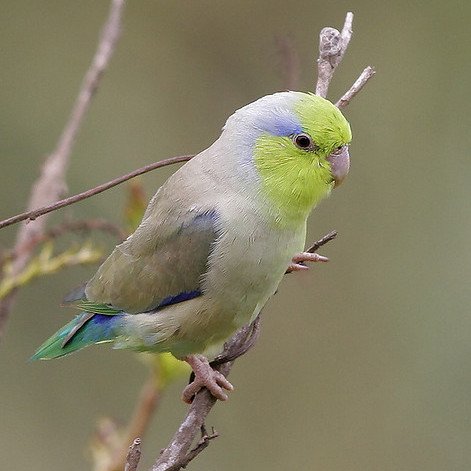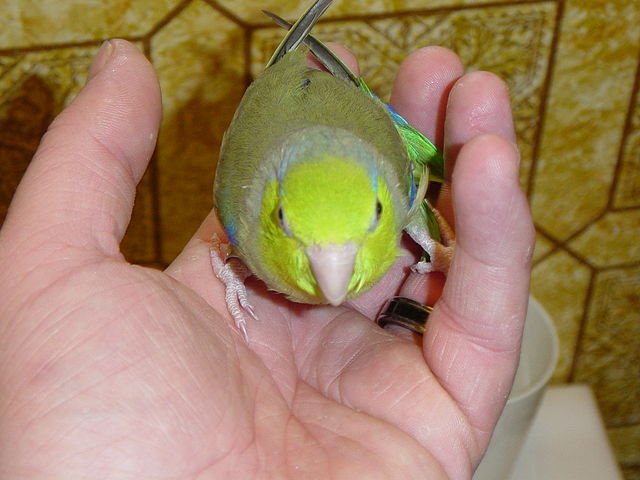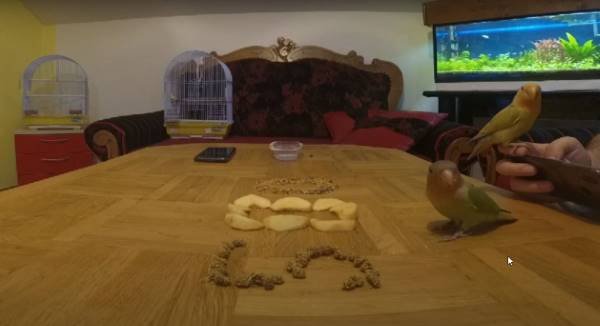Famed among the lovers of pocket parrots, Pacific Parrotlet or the Celestial Parrotlet is a small bird that is famous among beginners and kids. Though identical to most of the other parrot species, there is more to their personality other than just being petite and green. Let’s know the basic facts about Pacific Parrotlets right from their habitat to diet and care.
Quick Facts about Pacific Parrotlets
Habitat
Lowlands of South America are the original habitat of Pacific Parrotlets. They are mostly found in the dry regions of the deciduous forests and deserts of western Peru, western Ecuador, and southwestern Columbia. Nowadays, they have adapted to the humid areas too after wide-scale deforestation in their habitat. Pacific Parrotlets are flock birds and can be spotted in huge flocks as large as 100 birds in their habitat sitting and flying together.
Size & Weight
These sparrow-sized parrots are pint-sized and measure only 5 inches on an average. However, depending on their genetics and sex, this size may vary anywhere between 4.5 to 5.5 inches. This size is measured from head to tail. Their wingspan is averaged at around 6 inches. And the weight of Pacific Parrotlet is a meager 26 grams. However, this average weight can vary 2-3 grams depending on the diet and gender of the bird.

Lifespan
The lifespan of Pacific Parrotlet varies with varying habitats. There is a huge gap in their lifespan while living in the wild and captivity.
- Pacific Parrotlet’s lifespan in the wild has been recorded between 10 to 15 years. This lifespan is way lower than their counterparts living indoors. The shorter lifespan is often attributed to reasons like lack of proper diet, danger from predators in the wild, and no medical or general care in the woods.
- Pacific Parrotlet’s lifespan in captivity has been recorded at an impressive 20 years. And this is just the lower spectrum of the scale. They have been recorded to live until 30 years of age. Many of these pocket parrots tend to live until 25 years on average. But to achieve such longevity, a good diet, proper care, and attention is the key.
Color & Markings
Pacific Parrotlets colors and markings prove them as the grue parrots with green plumage and crooked parrot beak. They are a miniature version of their larger cousins: the Amazons. Just like the Amazon parrots, Pacific Parrotlets’ tails are short and lend them the stocky look. But what makes them stand out of all the other petite green parrot species is the bluish streak of feathers behind the eyes and on the wing coverts and the rump.

Pacific Parrotlets are dimorphic species and can be distinguished from this very unique blue streak. Where such a streak is prominent in all the male birds, it is either missing in the females or faintly colored.
Apart from this, many breeders have tried numerous color mutations of Pacific Parrotlets like Blue, Lutino, Albino, American Yellow, European Yellow, Pied, Fallow, Dilute Green, Dark Factor, Pastel, Cinnamon to name a few.
Diet
Pacific Parrotlets diet in the wild is full of all kinds of seed heads, fruits, berries, and blossoms. But while in captivity they eat whatever they are fed by their pet parent.
What do Pacific Parrotlets eat?
Pacific Parrotlets diet in captivity is wholesome and of the highest quality as the pet parents try their best to serve them a nutritious and balanced feed:
Just like in the wild, it is imperative to feed some seeds to these little parrots. Quinoa, chia, millet, buckwheat, sunflower, pumpkin, are all a few great examples that are likened by Pacific Parrotlets. One can also feed a mix of 2-3 seeds for variety. Seeds are best served sprouted as it reduces the fat content in them and prevents the bird from getting obese. Always prefer homemade seed-mix over the market-bought one as it does not contain any artificial additives.
Another food item that must form a part of Pacific Parrotlet’s daily feed is pellets. Pellets have everything that the daily diet of the pet bird might be missing in. It contains a full profile of all the necessary vitamins and minerals. This helps in covering the deficiencies if any. Always choose a high-quality brand as artificial additives are missing from them.
Another favorite and must-have item on the menu of the Pacific Parrotlet is a platter full of fruits and vegetables. Offer them fresh at least once a day as they are wholesome. Except for the pitted ones, one can offer almost all of the fruits and vegetables like apples, bananas, mangoes, plums, berries, winter squash, carrots, pumpkin, broccoli, et al. One can also add leafy greens like kale, spinach, bean greens, collard greens, et al.
The life necessity; water, also forms an important part of the Pacific Parrotlet diet. It not only quenches the thirst of these little birds in warm weather but also performs numerous body functions like regulating body temperature, keeping the bird hydrated, and transporting all the essential nutrients of food throughout the body. Make sure to serve freshwater of drinkable quality which is free from all the harmful metal toxins and harsh salts. Do not forget to double up the supply on hot days.
Like all other pet parrots, Pacific Parrotlets are also prone to certain deficiencies like that of calcium or minerals. Such deficiencies can sometimes be fatal for the bird such as egg binding. To prevent all such life-threatening conditions, it is advised to add cuttlebone or mineral blocks to their daily feed. The best way is to hang them near the perches inside the bird’s cage.
Breeding
It is only about a decade or so that the breeding of Pacific Parrotlets has piqued the interest of the breeders due to increased demand by the bird lovers. It was quite a challenge to breed these tiny parrots initially but nowadays, they are famed for being easy to breed any time of the year. That said, breeding them in extreme weather must be discouraged strictly for a lesser rate of survival. Some quick facts about breeding Pacific Parrotlets:
- Pacific Parrotlets love small fleece huts for private activities like snuggling and breeding. But if it is not possible to arrange one to hang inside their cage, offer them a nest box that is small and gives them a snug fit. Line it with organic wood shavings to add warmth. The best place for the nest box is the rear of the normal cage of the parrotlet.
- They achieve sexual maturity at around 2 years and prefer rainy months for breeding. The female starts preparing the nest for breeding purposes. Though the pair can easily lay two clutches every year, it must be strictly discouraged to prevent calcium deficiency in the hen.
- Every clutch includes 4 to 8 eggs but the young pair can sometimes lay a less as two or three eggs in every clutch. The eggs are incubated solely by the hen for three weeks. The male takes care of the nest activities.
- It takes about four weeks for the chicks to fledge. But to leave the nest and gain independence, they typically need another two weeks.
Care
Caring a Pacific Parrotlet in captivity is imperative to lend longevity to the bird. Caring includes every aspect of physical and mental wellness.
The first step to care for these little birds is offering them an apt cage to live. With such a playful and active personality, a cage of at least 18 inches in length, width, and height is a must. And that is just not enough. Making the cage worthy of living is as important. Add various toys for the bird to keep him from getting bored. And for flexing those wings to stay fit, do not forget to add a few perches of varying thickness and size.
Keep the surroundings of the bird clean to prevent bacteria and other parasites from breeding. More often than not, such parasites end up being the cause of fatal diseases. Wipe the cage of the bird every 12-15 days. Wash all the food and water bowls daily.
Personal hygiene like grooming is another way of taking care of the bird. Trimming the nails and beak of the bird to prevent them from overgrowing is an important part of the care regime of the Pacific Parrotlet.
Do Parrotlets like baths?
Like all other pets in the world, Pacific Parrotlets must also be made used to bathing early on. This will prevent the bird from feeling uncomfortable with water. To make the parrotlet love water early on, one can use interesting ways to attract the bird to water. Adding toy beads or lettuce to the bathing bowl is one of the best ways of making these birds love water. If done right, Pacific Parrotlets fall for baths.
Lastly, getting the bird to the vet for a regular medical checkup is essential. This helps in knowing the internal health of the bird and any underlying illness thereby.
Pacific Parrotlets as Pets
Though not as popular as pets a few decades ago, Pacific Parrotlets’ demand has shot up in recent years for their playful, intelligent, and fun personality. They are no less than any other large parrot albeit in a small body. Let’s know the highlights of their personality as pets.
Talking Ability
Tweeting, chirping, and chattering are the general vocalizations of Pacific Parrotlets like all other parrot species. But these little personalities are intelligent enough to be able to talk.
Can Pacific Parrotlets talk?
With a similar voice box like humans, Pacific Parrotlets can be easily taught speech. All it needs is a little technique and a lot of patience. Just like other medium-sized parrots, they can be taught words and short phrases with practice. The males are recorded to have more proficiency in speech when compared with their female counterparts. That said, the Pacific Parrotlets, in general, lack the talking ability of an African Grey or Quaker Parrot.
Noise Level
Just like all other parrot species, the Pacific Parrotlets too let out their customary contact calls every morning and evening. But talking about the general noise level, all they do is chirp and chatter when they are playful and happy. And these sounds can, by no means, be considered as noise just like a few other parrot species like conures.
Are Pacific Parrotlets loud?
With that small lung size, Pacific Parrotlets cannot be overly loud. They can only be loud enough to be heard just inside the house. So much lesser their noise is in decibels, that they are generally considered one of the best apartment birds.
Biting
Like other parrots, Pacific Parrotlets bite too. It usually starts after the weaning period and this is the apt time to train them not to bite. Sometimes, they can also bite out of frustration or anger.
But not all bites are a sign of hatred. In the wild, Pacific Parrotlets mate for life and they assume their favorite human as their mate in captivity. This drives the emotion of jealousy inside them. And when they see their human mate not paying attention to them or dedicating his time to other family members, it is natural for the bird to bite to claim his mate. This behavior is also noticed in the wild when the male Pacific Parrotlet bites the female to drive her away from the flock and to the nest.
Do Parrotlet bites hurt?
Pacific Parrotlets biting can be quite harsh and painful. They have a strong beak that can bite as hard as any big parrot. The bite of the Pacific Parrotlet can sometimes be even a little bloody. Hence, it is always better to hold them with a towel until they are taught not to bite.
Bonding with humans
Pacific Parrotlets are affectionate birds which makes them bond well with their flock members; other parrotlets or humans. They socialize pretty quickly when given a dedicated time daily. It is common to hear about these little birds being all playful, happy, and chirpy with their favorite human during the me-time they have.
Do Parrotlets like to be held?
Pacific Parrotlets love to be held by their favorite human. They are famed to ride their parents’ shoulders or hide inside their scarves or pockets and be all-loving and touchy.

Are Parrotlets cuddly?
Being extremely social, Pacific Parrotlets can be very cuddly. But to bring that part of their personality out, there must be a great bond between them and their pet parent. Once that level of comfort is achieved, they can be cuddly and affectionate all day long.
Compatibility with other Birds
Pacific Parrotlets are extremely social when it comes to their flock members; be it human or other Pacifics. But when it comes to bond with other species, they fail miserably. This can very well be accredited to their territorial nature which makes them stand against the other cage mates than beside them. Famed as large parrot personalities in a small body, they often end up picking fights like big parrots. So, it is best not to house Pacific Parrotlets with other parrot species.
Can 2 Parrotlets live together?
Parrotlets are infamous for their aggression and this makes even the experts warn against housing two parrotlets together. Housing two parrotlets can make them end up in fights. However, if two parrotlets are housed together early on, more often than not, they end up forming stronger bonds than otherwise.

What birds can Parrotlets live with?
With that aggression and territorial nature, Parrotlets aren’t the ones that are safe to house with other birds. As mentioned earlier, they are a personality of a larger parrot in a small size, they like to exercise dominance over the cage and cage mates. There have been instances of them being housed with another famous small-sized parrot Budgies, but not much success has been reported. With Budgies’ calm temperament, Parrotlets have proven to be dangerous for the safety of the little Budgies.
That said, there have been instances with Parrotlets living with the likes of few other similar-sized birds successfully too but with a condition: they must be housed early on in their life. That means the time when they are just born and cannot distinguish between flock and stranger birds.
Summing Up
Pacific Parrotlets, hence, make up a great pet with all the chirping and liveliness all day long. They bond great with their favorite human and are cordial with other family members, unlike other pet parrots that happen to become obsessed with a single person. So, are Pacific Parrotlets a family bird or not?
Are Parrotlets one-person birds?
While in the wild, Pacific Parrotlets mate for life and stay connected and social with remaining flock members. This inherent behavior of theirs gets mapped in the captivity family set up. They perceive their favorite human as their mate and the family members as flockmates. Hence, they aren’t strictly a one-person bird.
Pacific Parrotlets are, thus, the ultimate family companion for years.




